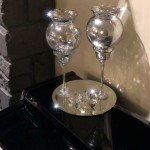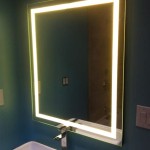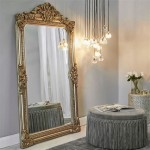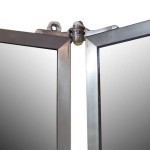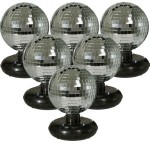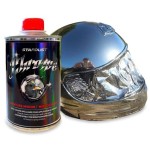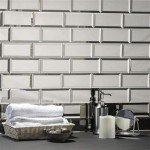Vintage Beveled Wall Mirrors: A Reflection of Elegance and Craftsmanship
Vintage beveled wall mirrors represent a unique blend of functionality and artistry. More than simply reflective surfaces, they serve as decorative elements capable of enhancing the aesthetics of any space. Their enduring popularity stems from their timeless appeal, intricate detailing, and the touch of history they bring to a room.
The defining characteristic of a beveled mirror is its angled edge. This sloping cut, achieved through a specialized grinding process, creates a frame-like effect around the mirror's perimeter. This bevel can vary in width, impacting the mirror's overall appearance. A wider bevel creates a more dramatic and pronounced frame, while a narrower bevel offers a subtler, more understated aesthetic.
The creation of a beveled edge is a testament to craftsmanship. Historically, this process was carried out entirely by hand, requiring significant skill and precision. While modern techniques may involve automated machinery, the fundamental principles remain the same. The glass is carefully positioned against a grinding wheel, which gradually shapes the edge to the desired angle. This process requires careful control to achieve a consistent bevel and avoid damaging the mirror surface.
The term "vintage" applied to a beveled mirror signifies a piece originating from a past era, typically several decades old. This historical context imbues the mirror with a unique character and charm. Vintage mirrors often reflect the design sensibilities of their time, showcasing specific stylistic elements popular during their production period. These elements might include Art Deco geometric patterns, Victorian floral motifs, or the sleek lines of mid-century modernism.
The appeal of vintage beveled mirrors extends beyond their decorative qualities. They possess a unique ability to enhance the perception of space within a room. By reflecting light and surrounding objects, these mirrors create an illusion of depth and openness, making a room feel larger and brighter. This is particularly beneficial in smaller spaces or rooms with limited natural light.
Identifying authentic vintage beveled mirrors requires attention to detail. Examining the mirror's construction, materials, and overall design can offer valuable clues about its age and provenance. Authentic vintage mirrors often feature thicker glass than their modern counterparts. The backing of the mirror can also be insightful, with older mirrors often having a wooden or metal backing rather than the more contemporary plastic backing.
The condition of a vintage mirror is another crucial factor to consider. While minor imperfections, such as slight scratches or patina on the frame, can add to the mirror's character and authenticity, significant damage should be carefully evaluated. Chips in the bevel, deep scratches on the mirror surface, or significant deterioration of the frame can detract from the mirror's aesthetic value and potentially compromise its structural integrity.
Integrating a vintage beveled wall mirror into a modern interior can be a stylish way to introduce a touch of history and elegance. These mirrors can serve as focal points in living rooms, dining rooms, or entryways. They can also be used strategically in smaller spaces like bathrooms or hallways to create an illusion of spaciousness. When choosing a location for a vintage mirror, consider the surrounding décor and lighting to ensure the mirror complements the existing aesthetic.
Maintaining the beauty and integrity of a vintage beveled wall mirror requires appropriate care. Regular cleaning with a gentle glass cleaner and a soft cloth can help maintain the mirror's reflective surface. Avoid using harsh chemicals or abrasive cleaners, as these can damage the glass or the frame. When handling a vintage mirror, exercise caution to avoid chipping the bevel or scratching the surface. Storing or transporting vintage mirrors should be done with care, ensuring they are adequately protected to prevent damage.
The market for vintage beveled wall mirrors offers a wide range of options, from smaller, simpler designs to large, ornate pieces. Prices can vary significantly based on the mirror's size, age, condition, and stylistic features. Antique shops, flea markets, and online marketplaces are common sources for these unique pieces. When purchasing a vintage mirror, it is advisable to inspect it thoroughly to ensure its authenticity and condition. Detailed photographs and accurate descriptions from sellers can be invaluable in making informed purchasing decisions.
Beyond their functional role, vintage beveled wall mirrors represent tangible pieces of history. They offer a glimpse into past design trends and reflect the craftsmanship of bygone eras. Incorporating these mirrors into a modern home can add a touch of timeless elegance and create a visually captivating focal point, bridging the past with the present.

Vintage Bevelled Edge Art Deco Wall Mirror With Shield Shape Decor

Vintage Large Oval Bevelled Edge Wall Mirror Art Deco Beveled

Brass Beveled Wall Mirror For At Pamono

Vintage French Style Gold Gilt Beveled Wall Mirror

Vintage Bevelled Edge Wall Mirror Art Deco Frameless Beveled

Antique Victorian Etched Reverse Painted Floral Picture On Beveled Wall Mirror

Vintage Beveled Wall Mirror Rectangular Norway

Vintage 1960s Frameless Beveled Wall Mirror With Gilded Corners Chairish

Vintage Ina Mirror Co Gold Beveled Wall 34 X 22

Vintage English Beveled Mirror 1950s For At Pamono


